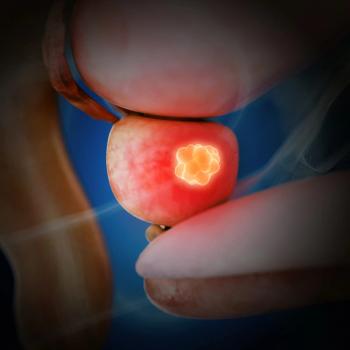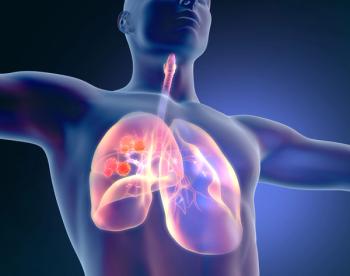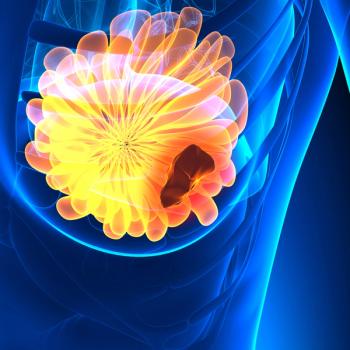
Cretostimogene Grenadenorepvec Displays Efficacy in BCG-Unresponsive NMIBC
Complete response rates were observed consistently across patient subgroups in those with high-risk BCG-unresponsive non-muscle invasive bladder cancer.
Intravesical cretostimogene grenadenorepvec (CG0070) was highly effective and very well-tolerated in heavily pretreated patients with high-risk BCG-unresponsive non–muscle invasive bladder cancer (NMIBC) with carcinoma in situ (CIS), according to data from cohort C of the phase 3 BOND-003 trial (NCT04452591) presented at the
Findings revealed that, at a data cutoff of March 14, 2025, the complete response (CR) rate in the overall patient population was 75.5% (95% CI, 66.3%-83.2%; n = 83). At a landmark of 12 months, the CR rate among 110 patients was 46.4% (95% CI, 36.9%-56.1%); the CR per a Kaplan-Meier estimate was 50.7% (95% CI, 40.9%-59.8%). At the 24-month CR landmark, the CR rate among 101 evaluable patients was 33.7% (95% CI, 24.8%-43.8%), with 9 ongoing CRs that have yet to reach the 24-month assessment. The Kaplan-Meier estimated 24-month CR was 42.3% (95% CI, 32.7%-51.6%). Of note, all CRs were centrally confirmed, with local to central concordance in 96.3% of assessments.
“Cretostimogene offers a highly effective, well-tolerated and durable treatment option for patients with NMIBC that's unresponsive to BCG,” Mark D. Tyson, MD, MPH, a urologic oncologist at the Mayo Clinic in Phoenix, Arizona, said in a presentation of the data. “It's scalable in everyday urology practice with a very familiar workflow, administered by the nurses, and its mechanism of action allows for it to be used either as a monotherapy or in rational drug combinations. I certainly look forward to future trials building on that foundation of the bladder-sparing landscape.”
Background and Design of the BOND-003 Trial
In January 2024, the
The open-label, single-arm study evaluated cretostimogene monotherapy in patients with pathologically confirmed high-risk BCG-unresponsive NMIBC and CIS with or without Ta or T1 tumors (n = 112).1 Patients on the study were also required to have all high-grade Ta/T1 disease resected prior to cretostimogene treatment and must have undergone mandatory biopsies at 12-month assessment.
Eligible patients underwent weekly induction for 6 weeks; nonresponders received a second weekly induction for 6 weeks. Patients then received a maintenance course weekly for 3 weeks, followed by once every 3 months during the first year and weekly for 3 weeks once every6 months for 2 to 3 years thereafter. The primary end point of the study was CR at any time; secondary end points include CR at 12 months, duration of response (DOR), recurrence-free survival (RFS), progression-free survival (PFS), cystectomy-free survival (CFS), and safety.
Among the 112 patients on the study, the median age was 74.0 years (range, 43-90) and the mean age was 72.9 years (SD, 9.19). The majority of patients were male (74.1%). Notably, the median number of prior instillations regarding BCG history was 12 (range, 7-66). The T-stage at study entry included CIS with high-grade Ta/T1 (19.6%) and CIS alone (80.4%). A total of 47.3% of patients received 1 or more prior therapies. Prior therapies other than BCG included serial adjuvant chemotherapy (30.4%), and systemic immunotherapy (6.3%).
Additional Efficacy Data
At 24 months, 97.3% of patients (n = 110) were free from progression to MIBC, and 84.5% avoided radical cystectomy. However, 82.4% of those who received radical cystectomies (n = 17) were T0 or NMIBC at this time. Of note, cretostimogene showed a best-in-class duration of response in patients with high-risk BCG-unresponsive NMIBC, with an estimated DOR probability of 64.1% (95% CI, 52.4%-73.7%) at 12 months. At 24 months, the estimated DOR probability was 58.3% (95% CI, 46.3%-68.5%). At a median follow-up of 22.3 months, the median DOR was 27.9 months and is ongoing (95% CI, 14.3-not evaluable). Moreover, 91% of patients who achieved a CR at 12 months are projected to maintain their CR at 24 months. This suggests that the agent’s mechanism of action is innate to adaptive switching with immunogenic memory and a long immuno-oncology tail, investigators noted.
Responses were sustained over 45 months, with 50.0% of patients reinduced with oncolytic immunotherapy converted to CR. Of these patients, 64.3% had a durable response after the conversion to CR. Patients also maintained responses after completing treatment.
Across patient subgroups—including those previously treated with chemotherapy—CR rates were consistently high. The subgroups included patients who had prior intervening therapy other than BCG (75.0%; 95% CI, 61.05%-85.97%); did not receive prior intervening therapy other than BCG (75.9%; 95% CI, 62.83%-86.13%); had CIS alone at study entry (77.3%; 95% CI, 67.11%-85.53%); CIS plus T1 disease at study entry (80.0%; 95% CI, 28.36%-99.49%); CIS plus H0 Ta/T1 disease at study entry (68.2%; 95% CI, 45.13%-86.14%); BCG refractory after prior BCG therapy (73.2%; 95% CI, 62.24%-82.36%); and BCG relapsed after prior BCG therapy (82.1; 95% CI, 63.11%-92.94%).
“We observed minimal variation in CRs across the entire cohort, regardless of the number of BCG exposures prior to cretostimogene [grenadenorepvec] exposure or baseline tumor characteristics,” Tyson said during the presentation. “CRs were robust [in various] disease states, such as BCG relapsing disease, where patients are thought to have a suppressed but intact immune system, or BCG refractory disease, where patients are thought to have an exhausted tumor microenvironment. Even those with high-risk T1 patients had excellent CRs in BOND-003.”
Safety Data
Most patients on the study experienced at least 1 any-grade treatment-related adverse effect (TRAE; 63.4%; n = 71/112). No grade 3 or higher TRAEs or treatment-related discontinuations were reported. The most common any-grade TRAEs reported in at least 10% of patients included bladder spasm (25.0%), pollakiuria (21.4%), urgency (20.5%), dysuria (16.1%), and hematuria (13.4%). Notably, the median time to TRAE resolution was 1 day. Grade 2 serious TRAEs were seen in 1.8% of patients.
References
- Tyson M. BOND-003 cohort C- a phase-3, single-arm study of intravesical cretostimogene grenadenorepvec for high-risk BCG-unresponsive NMIBC with CIS. Presented at: American Urological Association Annual Congress; April 26-29, 2025; Las Vegas, NV. P2s.
- CG Oncology receives both FDA fast track and breakthrough therapy designation for cretostimogene grenadenorepvec in high-risk BCG-unresponsive non-muscle invasive bladder cancer. News release. CG Oncology, Inc. December 5, 2023. Accessed April 26, 2025. https://cgoncology.com/cg-oncology-receives-both-fda-fast-track-and-breakthrough-therapy-designation-for-cretostimogene-grenadenorepvec-in-high-risk-bcg-unresponsive-non-muscle-invasive-bladder-cancer/
Newsletter
Stay up to date on recent advances in the multidisciplinary approach to cancer.





















































































